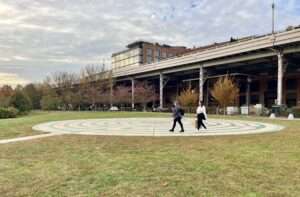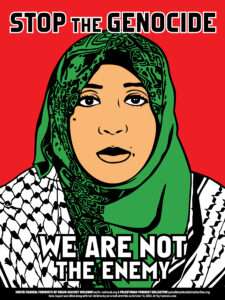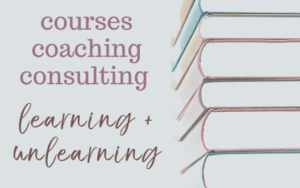To show up in this piece, which I’ve been trying to get out for weeks, I’ve realized that the only way to do so is to bring my full messy self. I don’t want to polish writing when that’s not true to the process or the way forward.
As writers, we often have lots of discarded text and false starts. And we often spend hours weaving threads together into a cohesive whole. I really appreciate this work, and it gives me joy to do the weaving. Stitch by stitch, I understand more, and connections become clearer through the writing itself. The process reminds me of old writing studies research about writing to learn as much as learning to write. Still, there are times when the threads aren’t coming together and when I keep dropping stitches (as I do when crocheting). Perhaps these times are invitations to let the seams and creases show? To embrace the dropping of stitches? And to drop the pressure to show up perfectly? There’s only the desire and ongoing need to keep showing up.
In this sprit, let me share a few snippets (scenes or stories) of unstitched text because the messiness is surely part of the message.
Scene 1: Remembering
The violence in Gaza brings me to my knees. Literally, daily, I am lying prostrate, forehead pressed to the ground, pouring out emotion, and pleading “may we be free from harm.” Through this embodied action, I have been remembering my concussion back at the start of 2018, in the last semester before leaving my faculty position, when I was literally brought to my knees and hit my forehead (my third eye or center of intuition). Talk about a divine intervention! The concussion meant that I literally could not work, whether or not I wanted to push through. It meant I had to get really, really clear on priorities and what could fall away. It meant that I could shed expectations I was still holding for myself, because I couldn’t come through, period. Now I wonder how many of us are metaphorically feeling concussed? Is lying prostrate another, perhaps-gentler way of remembering commitments—to get really, really clear on priorities?
Scene 2: Revising
Earlier this week, I showed up to facilitate a writing workshop for faculty, and I realized in the first few minutes that no one had capacity for a writing workshop in November, especially this November. I quickly pivoted to a combination of writing time and one-with-one consultations. I was so glad that I didn’t follow plans, but felt (again) how much our institutions are pushing us to keep going (and performing) when it doesn’t make any sense. I wished (again) that we could be more real about where we are. I keep sending emails saying “what times we’re in” and receiving emails saying “we’re at that time of year.” But aren’t we always in these times and at that time of year? How could I release expectations and revise these phrases as I did the workshop?
Scene 3: Rebelling
Back in January, I choose “well” as my word for the year, imagining a deep well of support, a wellspring of writing to pour forth, and a welcoming of wellness. And in the true style of “be careful what you wish for” (or more precisely: life gives you want you’re seeking, but not in the ways you imagine), I have found myself raging this year against expectations for “wellness.” Imagine a toddler stomping. Or a teen slamming the door. “By damn, I will not be well! How can any of us be well in the midst of so much? Even as resistance to so much?” Of course, I can get myself out of the temper-tantrum. But underneath it, I long for deep acknowledgement of collective struggle and strife—of the “myth of normal” (Maté) and need for “decolonizing therapy” (Mullan). It feels crazy-making to expect wellness without acknowledgement of how unwell we collectively are. How might remembering, revising, and rebelling all be part of this acknowledgement? (And look what I did just there. As a writer, I am still trying to stitch it all together. :-))

This photo shows the public labyrinth in Georgetown, one of the places where I have grounded myself in the past few weeks—to get centered and listen to guidance toward also continuing to feel-learn-and-act (heart-head-hands). Shoring up inner reservoirs for continued outcry against violence in Gaza and toward Palestinian liberation.
Scene 4: Stitching Something Together
I have been writing these snippets/scenes, trying to stitch something together. Trying to speak about our heartfelt aches through everyday moments. Trying to recognize and honor struggles, to repeat truths again and again, and to implore (on knees) continued action—truly outcry—for Palestinian liberation. So, what do these stitches add up to?
Some Stitches of Recognition
I want to recognize that so many of us are struggling in various ways, not just as individuals, but because of larger, systemic, institutional injustice. November this year is both different and similar to years past. We’re at the time of year when, in years past, I’ve been writing about being a killjoy, blocking the harms of Thanksgiving, and doing the holidays differently because the holidays are hard. All of the emotional heartbreaks, intensity, and mythical norm expectations of “the holiday season” are with us again this year. And, arguably, exhaustion, burnout, and related gaslighting have intensified as now we are having to insist: yes, we are still in a pandemic, and no, we really can’t do more. I want to say repeatedly: “you aren’t alone!” And I want to recognize and honor each of us in these and many more related struggles.
Some Stitches to Resist and Recover from Denial
I want to work against gaslighting because it’s real and continuing around many things—from the ongoing pandemic to the violence, genocide, Nakba in Gaza. I often feel my writing repeats things that I say to myself or say to friends or that friends say to me or that I wish I heard from friends. I am sure this is because I want to say again and again (as many times as possible): “this really is happening!” Global events can feel far-removed, but rarely are they. I know that I am not alone in being gutted, heartbroken, and brought to my knees by what is happening in Gaza. If my writing can make someone feel less alone, that feels meaningful. If it can do more than that—if it can stir up feistiness or inspire action or remind someone to call again for ceasefire or present other intervention options—that is incredible. I know that I am deeply grateful for everyone who is calling, reporting, marching, and finding many creative ways to write and speak out these days. I want my writing to say THANK YOU. I want it honor everyone resisting and recovering from denial.
Some Stitches for Continued Outcry
I want to implore us to keep showing up and acting for Palestinian liberation. I know the tough emotions of feeling small or squished or powerless within our totally not democratic context (another case of gaslighting). But those emotions tell only a bit of the story. It’s also true that we are incredibly powerful, especially when tapping into power with (relational, collective power) and power to (facilitative, mobilizing power). So, I want to speak back to those feelings of powerlessness and to tap into the power that’s in our hands. We need each of us. Now is a time to remember and reconnect with our commitments. Now is the urgent time to dig into the wells holding whatever reservoirs we might draw from.
Dropping Stitches and Still Taking Action, However Imperfectly: Resources, Gratitude, and Action Steps from Here
The urgency for a ceasefire is incredibly dire. And the urgency doesn’t stop with ceasefire because many surviving Palestinians are displaced, dispossessed, and facing decades of deep injustice. I know that I am dropping stitches again because there is just so much more to say. And saying something imperfectly is where I am now, so let me close by sharing resources, gratitude, and action steps from here.
I’ll keep posting actions via Instagram. And I hope you will keep sharing resources with me. Thanks especially to Rasha Diab, Ph.D. and Rev. Jenny Elisa Veninga, Ph.D. who are sharing updates and processing with me. And thanks to many of the organizations listed in my past resource-roundup posts: “Resources for This Moment: Understanding and Responding to What’s Happening in Palestine and Israel Now” and “More Resources for Learning and Taking Action to Prevent Genocide in Gaza.” Those posts name organizations to follow and support financially, when you can.
If you are seeking inspiration, check out the “Stop Gaza Genocide Action Toolkit” created by the US Campaign for Palestinian Rights. This toolkit includes 11 potential actions and links to many additional resources, including a google folder of images and infographics. This image—art Favianna Rodriquez (Favianna.com), sponsored by INCITE! Radical Feminists of Color Against Violence and Palestinian Feminist Collective—is one of these offerings to be downloaded and shared. This toolkit is an offering for all of us asking: What now?

Art by Favianna Rodriquez (Favianna.com)—sponsored by INCITE! Radical Feminists of Color Against Violence and Palestinian Feminist Collective.
The question of what now? relates to the question of how to be? How to be well and to be real? Not to suppress feeling (heart), to stop un/learning (head), or to limit acting (hands) for perceived personal wellness. But to tap into and keep shoring up inner reservoirs for continued outcry. Crying out for truth-telling, repair, and justice. Crying out for Palestinian liberation and liberation for all peoples. Crying out for justice and the ought to be. In the here-and-now and for the long-haul.
So much gratitude is due to everyone crying out and teaching us how to outcry.
Gratitude especially for Angela Y. Davis and her book Freedom Is a Constant Struggle: Ferguson, Palestine, and the Foundations of a Movement. I am so grateful that I started 2023 with this book and take this gratitude as a message to continue reading widely the work of Black feminists and feminists and womanists of color. Deep grounding (a well dug deep) is essential.
Relatedly, BlackWomenRadicals has shared “Solidarity with Palestine—A Radical Black Feminist Mandate: A Reading List” and highlighted this call to action from 2014, which feels ever-timely:
“We call upon all people of conscience to stand with Palestine and to join the worldwide actions in which communities and civil society are stepping up in critical ways. We recognize that all our struggles for social, racial, gender, and economic justice and for self-determination are deeply interconnected and can only gain strength and power from one another. As Audre Lorde taught us, “When we can arm ourselves with the strength and vision from all our diverse communities then we will in truth all be free at last.” —Statement in Solidarity with the Palestinian People of Gaza, 2014, in For Harriet
And ongoing appreciation for Jewish Voice for Peace and Jewish activists disrupting the conflation of anti-Zionism with antisemitism. Two sources to mention include Dave Zirin’s “The Left Is Not ‘Anti-Jewish’” (from November 6, 2023) and “On Antisemitism, Anti-Zionism, Dangerous Conflations” (A Jewish Voice for Peace and PARCEO Explainer).
Finally, for updated news, consider following the Institute for Middle East Understanding (IMEU), human rights attorney Noura Erakat, and Democracy Now!
—
This post is written by Beth Godbee, Ph.D. for Heart-Head-Hands: Everyday Living for Justice. A few highlights:
- Monday 11/20: Next One-Day Writing Retreat
- Workshop 12/15: “Practices for Navigating Burnout” offered collaboratively with Candace Epps-Roberts, Ph.D.
- Blog Post Revisited: “Doing the Holidays Differently: Untangling from the Mythical Norm and Revising Rituals for ‘the Holiday Season’”
- Related Past Post: “Countering Resistance Fatigue with a Both/And Approach”



Thank you. I feel less alone in my heartbreak and yes rage.